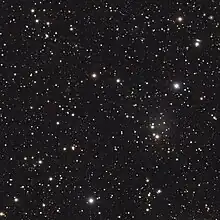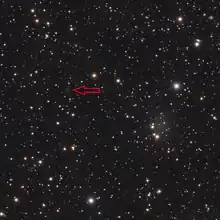| DGSAT I | |
|---|---|
 | |
| Observation data | |
| Right ascension | 01h 17m 35.59s[1] |
| Declination | 33° 31′ 42″[1] |
| Redshift | 78 Mpc[1] |
| Heliocentric radial velocity | 5450 ± 40 km/s[1] |
| Distance | 254.4 ± 3.3 Mly (78 ± 1 Mpc)[1] |
| Apparent magnitude (V) | 18.18 ± 0.04[1] |
| Absolute magnitude (V) | -16.3 ± 0.1 mag[1] |
| Characteristics | |
| Mass | 4.0 × 10×108[1] M☉ |
| Mass/Light ratio | 1.1[1] M☉/L☉ |

DGSAT I is a quenched, ultra diffuse galaxy (UDG) located on the outskirts of the Pisces-Perseus Supercluster, identified in 2016 during a visual inspection of a full color image of the Andromeda II dwarf galaxy.[1] DGSAT I resides in a low-density environment compared to the densities where UDGs are typically found.[2] Its chemical makeup have led astronomers to propose it was formed during the dawn of the universe when galaxies emerged in a different environment than today.[3][4][5][6]
Discovery and identification
DGSAT I was first identified by the DGSAT project in 2016.[7] The DGSAT (Dwarf Galaxy Survey with Amateur Telescopes) uses the potential of privately owned small-sized telescopes to probe low surface brightness (LSB) features around large galaxies and aims to increase the sample size of the dwarf satellite galaxies in the Local Volume.[7][8]
At first astronomers thought DGSAT I to be an isolated dwarf galaxy beyond the Local Group due to its structural properties and absence of emission lines. An spectroscopic observation later revealed DGSAT I to be a background system and likely associated with an outer filament of the Pisces-Perseus super-cluster.[7]
Chemical composition
The chemical composition of a galaxy provides record of the ambient conditions during its formation. The mass ratios of alpha-elements such as magnesium to iron ([Mg/Fe]) trace time-scales for star formation, as these elements are produced by stars according to different lifetimes.[2] Younger galaxies tend to have more heavy elements in its chemical makeup compared to ancient galaxies formed during an early age of the universe.[3]
DGSAT I's integral field spectroscopy data shows a remarkably low iron content, suggesting an early galaxy formed from a nearly pristine gas cloud, unpolluted by the supernova death of previous stars, however its magnesium levels are consistent with what astronomers expect to find in younger galaxies.[3] This apparent chemical makeup discrepancy and DGSAT I's isolation from galaxy clusters are helping astronomers to develop new theories concerning the birth and formation of UDGs.[3]
UDGs are hard to observe due to their extremely low luminosity but there are studies being conducted using the Keck Cosmic Web Imager in an attempt to shed light on the precise relation between DGSAT I's metallicity and its possibly exotic origin.[2] A paper published in 2022 proposed DGSAT I to be a “failed galaxy” that formed relatively few stars in proportion to its halo mass, and could be related to cluster UDGs whose size and quiescence pre-date their infall[9] (i.e. when molecular transition shows evidence of gas flowing into the core of the star).
See also
References
- 1 2 3 4 5 6 7 8 9 10 Martínez-Delgado; Läsker; Sharina; Toloba; Fliri; Beaton; Valls-Gabaud; Karachentsev; Chonis; Grebel; Forbes; Romanowsky; Gallego-Laborda; Teuwen; Ómez-Flechoso; Wang; Guhathakurta; Kaisin; Ho (2016). "Discovery of an ultra diffuse galaxy in the Pisces-Perseus Supercluster". The Astronomical Journal. 151 (4): 96. arXiv:1601.06960. Bibcode:2016AJ....151...96M. doi:10.3847/0004-6256/151/4/96.
- 1 2 3 Martín-Navarro; Romanowsky; Brodie; Ferré-Mateu; Alabi; Forbes; Sharina; Villaume; Pandya; Martínez-Delgado (2019). "Extreme chemical abundance ratio suggesting an exotic origin for an ultradiffuse galaxy". Monthly Notices of the Royal Astronomical Society. 484 (3): 3425–3433. arXiv:1901.08068. doi:10.1093/mnras/stz252.
- 1 2 3 4 "Anemic Galaxy Reveals Deficiencies in Ultra-Diffuse Galaxy Formation Theory – W. M. Keck Observatory". Retrieved 2023-10-31.
- ↑ Ciaccia, Chris (2019-03-08). "'Living fossil' from the dawn of the universe discovered in deep space". Fox News. Retrieved 2023-11-11.
- ↑ Parnell, Brid-Aine. "New Ghost Galaxy Is A Time Capsule From The Dawn Of The Universe". Forbes. Retrieved 2023-11-11.
- ↑ "Starry tail tells the tale of dwarf galaxy evolution". ScienceDaily. Retrieved 2023-11-11.
- 1 2 3 "Ultra-deep imaging with amateur telescopes - David Martínez-Delgado". ned.ipac.caltech.edu. Retrieved 2023-11-04.
- ↑ B. Javanmardi; D. Martinez-Delgado; P. Kroupa; C. Henkel; K. Crawford; K. Teuwen; R. J. Gabany; M. Hanson; T. S. Chonis; F. Neyer (2016). "DGSAT: Dwarf Galaxy Survey with Amateur Telescopes". Astronomy & Astrophysics. 588: A89. arXiv:1511.04446. doi:10.1051/0004-6361/201527745. S2CID 119189074.
- ↑ Janssens, Steven R.; Romanowsky, Aaron J.; Abraham, Roberto; Brodie, Jean P.; Couch, Warrick J.; Forbes, Duncan A.; Laine, Seppo; Martínez-Delgado, David; van Dokkum, Pieter G. (2022-10-07). "The globular clusters and star formation history of the isolated, quiescent ultra-diffuse galaxy DGSAT I". Monthly Notices of the Royal Astronomical Society. 517 (1): 858–871. arXiv:2209.09910. doi:10.1093/mnras/stac2717. ISSN 0035-8711.
External Links
Dwarf Galaxy Survey with Amateur Telescopes - DGSAT project's website